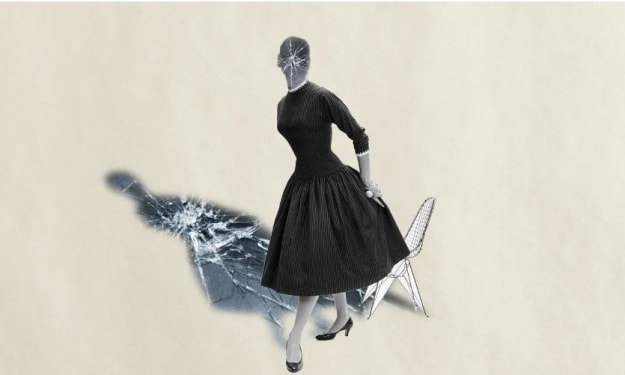
My painful periods started when I was about 14. I wore heat patches to school in the hope that they would help me last through the day. Sometimes they did. But sometimes I ended up in sick bay writhing in agony on the fold-out bed, where the receptionists didn’t know what to suggest because I’d already had my appendix removed.
Ten years of pain later, I’m finally in the process of being diagnosed with endometriosis. But far from simplifying my issues, what I’ve seen during my many doctor’s appointments is that the disease remains poorly understood – and that its diagnosis and treatment can be a complicated and life-long ordeal.
Endometriosis is a gynaecological condition associated with menstruation where tissue similar to the lining of the womb is found in other areas of the body, including the fallopian tubes, pelvis, bowel, vagina and intestines. In rare cases it has even been found in the lungs, eyes, spine and brain – in fact, the only place in the body it has never been found is the spleen. Symptoms include severe, sometimes debilitating, pelvic pain, fatigue and heavy periods.

While there are many lesser-known health conditions which are underfunded and under-researched, few are as common as endometriosis, which affects about 176m people globally. In the US, where, as in other countries, it’s estimated to affect one in 10 women of reproductive age, it receives about $6m (£4.7m) in research funding each year. Sleep research alone receives more than 50 times that amount.
More in the Health Gap:
• The mystery of the pelvic floor
• What is vulvodynia?
• The case for renaming women’s body parts
Pain isn’t the only consequence of endometriosis. One study across 10 countries found that endometriosis costs each patient an average annual total of €9,579 (£8,600) in healthcare, productivity and quality of life costs – that’s more than €26 (£23.45) a day. It may be linked to infertility. And then there is the chance that the pain itself makes patients vulnerable to other conditions.
“We have good evidence that having serious pain alters your central nervous system, alters how you respond to pain in the future and makes you potentially more susceptible to other chronic pain conditions,” says Katy Vincent, a senior pain fellow at the University of Oxford.

For women who are symptomatic, and many are not, the primary symptom is usually acute pelvic pain with no obvious physical cause. That may make it enigmatic. But that it was a health condition experienced only by women – and is linked to menstruation, in particular – has made it more of an enigma than it perhaps could be.
Ancient origins
Microscopic discovery of endometriosis is most often attributed to Czech scientist Karl von Rokitansky in 1860, though this is disputed and previous more rudimentary microscopic discoveries have also been recorded. Records of endometriosis-like symptoms, meanwhile, date back to antiquity. It also has an overlap with the condition ‘hysteria’, which derives for a Latin word for “of the womb”: one study of representations of pelvic pain in medical literature found that many cases dismissed as “hysteria” may well have been endometriosis. “The original meaning of hysteric convulsions during this era generally referred to women falling to the ground, doubled over in a foetal position,” the study notes. “They could very easily be describing a response to acute abdominal pain.”

The historic underestimation and misunderstanding of endometriosis continues to inform modern medicine. Researched less than other conditions, it’s also less understood. The cause of endometriosis is not known. There is no cure. It often takes up to around a decade to get diagnosed, and the only means of definitive diagnosis is a form of keyhole surgery known as laparoscopy.
I never remember a single GP or hospital doctor, anybody, saying the word ‘endometriosis’. Or just even asking the right questions – Alice Bodenham
I spoke to three women now diagnosed with endometriosis, all in their 20s and 30s. Along the way, all three had been misdiagnosed with other conditions and had their symptoms dismissed or underestimated. “I never remember a single GP or hospital doctor, anybody, saying the word ‘endometriosis’. Or just even asking the right questions,” says Alice Bodenham, 31. “It’s very much ‘it could be this’, or ‘you’re making it up’.”
Part of the problem is the systemic tendency to dismiss women’s pain, when pain is of the most common symptoms of endometriosis. I experienced this myself when I found one internal ultrasound scan acutely painful and informed the doctors: I later received my results in the post with the note “patient experienced mild discomfort during scan”. Making matters worse, there’s no correlation between the level of pain experienced and the severity of an individual’s condition.

As there are no non-invasive means of definitive diagnosis, without a physician believing a patient’s description of symptoms, there’s no referral for a diagnosis. But women’s symptoms, too, are often dismissed as being “all in your head”.
One UK survey found of 2,600 women with endometriosis found that 40% had visited the doctor 10 or more times before being referred to a specialist
It may be little surprise, then, that one UK government survey of 2,600 women with endometriosis found that 40% had visited the doctor 10 or more times before being referred to a specialist. Bodenham, for example, collapsed multiple times before her pain was taken seriously.
Caitlin Conyers, 24, who runs the blog My Endometriosis Diary, began to suspect she might have the condition through her own research, but this was dismissed by her physicians. “About three years ago I ended up in an urgent care centre. I’d been Googling the different causes and one was endometriosis and I did suggest this to the doctor at the time and they just said, ‘Oh no, it definitely isn’t that’,” she says. “I explained that I had really bad period pain and general abdomen pain and they still said no.”
Oxford’s Vincent isn’t hesitant about whether gender plays a role. “If every 14-year-old boy went to the GP saying, ‘I miss two days of school every month’, they would stop missing school every month,” she says.

Making matters more complicated, physicians also sometimes fail to find evidence of lesions on initial scans, particularly if the lesions are superficial. Endometriosis forums are littered with stories of false negative ultrasound scans.
A lack of awareness on the patient side can delay diagnosis too. Menstrual taboos still persist and two of the women I spoke to reported being told, whether by family or through sexual education, that periods might be painful or uncomfortable. What they never understood was how painful (or not) a normal period should be.

Endometriosis charities and campaigners around the world are working to raise awareness, and their efforts seem to hav helped. In 2017 the Australian government launched a National Action Plan For Endometriosis which seeks to “improve the treatment, understanding and awareness” of the condition, and increased funding to A$4.5m (£2.5m), new clinical guidelines and – crucially – for the subject to be made part of primary healthcare professionals’ medical education. In the UK, government advisory body the National Institute for Health And Care Excellent (Nice) released guidelines in 2017 with the aim of standardising diagnosis and treatment pathways for patients.
But while that’s a good step in the right direction, there already are many guidelines for GPs to juggle, says Anne Connolly, clinical champion for women’s health at the Royal College of GPs. Lone Hummelshoj, chief executive of the World Endometriosis Society, adds that the lack of specialist centres is another worldwide problem.
No quick fix
Even after a diagnosis is reached, symptom management is by no means straightforward –and misinformation persists here too.

Some medical practitioners still tell patients pregnancy is an effective treatment. One physician this year told me she suspected endometriosis – but, she added, “there’s not much we can do unless you fancy getting pregnant”. Given that the disease can impact fertility of patients, this seems at the very least insensitive. It’s also inaccurate: while it may relieve symptoms of endometriosis, it’s only for the duration of the pregnancy.
Meanwhile, writer and performer Lena Dunham raised the profile of hysterectomy as a treatment for endometriosis by writing about her choice to undergo the surgery in Vogue US earlier this year. But its use as a treatment for endometriosis is controversial. As the condition is characterised by lesions outside of the uterus not inside of it, its removal is by no means a cure and endometriosis can recur afterwards.
Hysterectomy is by no means a cure and endometriosis can recur afterwards
Because the development of endometriosis lesions is controlled by oestrogen, hormonal treatments are often one of the first prescribed. These can help manage the condition, but do not cure it, and can have their own side effects. A 2016 study by researchers in Denmark found that women using hormonal contraceptives were more likely to seek treatment for depression. (Watch our video on eight women who experienced serious side effects from the contraceptive pill).

Another potential treatment is medical menopause. However, it is not a long-term option because it can affect bone density, particularly in young people, and, although rare, one of the potential side effects cited by the brand Zoladex is accidental full menopause. Cook told me there is a lack of informed consent around the use of this treatment. She says, “One of the things I hear a lot of is the number of women who end up taking drugs or having injections to go into medical menopause and they do not realise that’s what it is.”
As such, there is research ongoing into potential alternatives.
“Drug treatments for endometriosis are entirely focused on hormones and we need something else because we know for a lot of women that doesn’t work very well,” says Krina Zondervan, a professor of reproductive and genomic epidemiology at the University of Oxford. “And it gives a lot of side effects that women are not that happy to experience in the long term.”
Although they treat only the symptoms, not the condition, painkillers are another option. But they aren’t without adverse effect, either. Bodenham tells me how the opioid painkillers she’s been taking for the past three years have left her with a constellation of side-effects including “anaemia and hypertension”. She says, “I used to run a 5k every week… and now some days just walking downstairs to get a glass of water feels like doing a marathon.”

Despite this, Bodenham feels lucky to receive them – she knows trying to access strong painkillers can lead to accusations of addiction. (There is also a risk that use of opioid painkillers will lead to abuse or dependency, although this is small among those with no history of substance abuse or addiction.)
There is some hope. The illness’ profile is on the rise and efforts are being made to educate GPs and patients about pelvic pain. But as patients wait for the medical system to catch up, their symptoms are still being misunderstood and their illnesses misdiagnosed with serious mental and physical health consequences.
Having found that birth control adversely affected my mental health, my next step is deciding whether to start treatment via the Mirena coil’s low dose of hormone, or to continue pursuing a definitive diagnosis via laparoscopy. But laparoscopy would require several weeks of recovery – and as a freelance writer with little job stability, I would need more savings than I have. It’s one more example of the difficult choices women with chronic pelvic pain face every day.
Correction: A previous version of this story inaccurately described one of Krystal Rodriguez’s symptoms as collapsing. This has been changed. We regret the error.






Comments
There are no comments for this story
Be the first to respond and start the conversation.